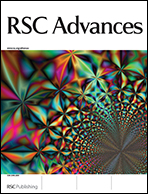Novel organic/inorganic/polymeric mesoporous luminescent hybrid materials were prepared by covalently linking the binary and ternary Eu3+ complexes to the functionalized ordered mesoporous SBA-15 with the modified polymer poly(ethylene glycol) (PEG) as a “bi-functional bridge”. PEG was firstly modified with the coupling agent 3-(triethoxysilyl)propyl isocyanate (TEPIC) and covalently bonded to mesoporous silica SBA-15 through a co-condensation method (designated as PEG-SBA-15). Then, the new type of luminescent hybrid material (designated as Eu(PEG-SBA-15)3) consisting of an inorganic Si–O network and an organic polymeric chain, was obtained by introducing the Eu(NO3)3 compound into the PEG-SBA-15 system via coordination reaction. With the addition of phen as the second ligand, the stronger luminescence intensity of the ternary Eu(PEG-SBA-15)3phen hybrid was found. FT-IR, SAXRD, N2 absorption measurements, TEM and photoluminescent spectra was used to characterize the hybrids. The results show that both the mesoporous hybrids exhibit the characteristic emission of Eu3+, high surface area, high ordered mesoporous structure and crystallinity, which suggests the polymer PEG can not only functionalize the mesoporous SBA-15 but also effectively sensitize the Eu3+. Moreover, the luminescence intensity, quantum efficiency and lifetime were enhanced by the introduction of ligand phen into the polymer functionalized mesoporous matrix.

You have access to this article
 Please wait while we load your content...
Something went wrong. Try again?
Please wait while we load your content...
Something went wrong. Try again?


 Please wait while we load your content...
Please wait while we load your content...